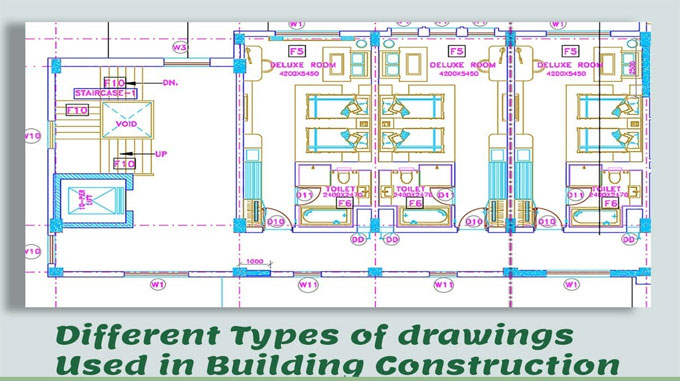
Common types of drawings found in building construction
In order to successfully complete any construction project (for buildings), construction documents, drawings, sketches and plans play an important role. Several types of documents are available to formulate your set. The requirements may vary according to clients and buildings. Besides, the drawing requirements for the project are also impacted by the range of the budget for the project.
The following types of drawings are commonly found in standard set of construction documents:
1. Architectural Drawings, 2. Electrical Drawings, 3. Plumbing Drawings, 4. Structural Drawings, 5. Fire Fighting Drawings, 6. HVAC Drawings
1. Architectural Drawings: Architectural drawing is treated as the mother drawing for all the other drawings applicable for construction. It is a technical drawing of a building (or building project) utilized by the architects to build up a design idea into an organized proposal. It comprises of all the details of the project like location site plan, setting out plan, elevations, sections and other details.
The following items are included in a full set of Architectural Construction Drawings:
1. Setting Out Plan
2. Floor Plans
3. Elevation Drawings
4. Section Drawings
5. Working Drawings
6. Opening Schedules
7. Rood Drainage Plan
8. Flooring Plan
9. Furniture Plan
10. Typical Details
2. Structural Drawings: The structural drawing is considered as the backbone of the building.
These drawings demonstrate the support system of the building like how the building is situated, what are different structural components of the building, what is the strength of the building and how beams, columns, stairs, slabs etc. are attached etc.
The structural drawings contain the following elements :-
a. General Notes
b. Typical sections
c. Foundation excavation plan
d. Footing sections
e. Ground floor column plan
f. Column sections
g. Ground floor plinth beams plan
h. Plinth beams sections
i. Ground floor beam plan
j. Beam sections
k. Ground floor slab bottom rebar detail
l. Ground floor slab top rebar detail
m. Ground floor slab section
n. Overhead water tank design
o. Septic tank design
3. Electrification Drawings: These drawings demonstrate the position and layout of different electrical equipments like electrical fixtures, switches, fan, light and other. It also shows the load calculation, tapping for electricity, wiring path and other interventions like AC and UPS and its constituents.
The electrical drawings include the following items :-
a. Electrical Legend
b. Floor Lighting Plan
c. Floor Power Plan
d. Single Line Diagram
e. Fire Alarm Layout
f. Floor Sound System and CCTV Camera
g. Equivalency Chart
h. Lightening Protection Earthing Details
4. General arrangement drawing (GAD): General arrangement drawings often comprises of expanded views of complex areas or details, and other supplementary information that aids in the approval process and throughout the installation phase.
5. Numeration drawing (NR): Numeration drawing primarily includes the dimensions of all the components provided in the structure.
6. Reinforced concrete drawing (RC): RC drawing points to the way in which detailing is performed for steel reinforcements toward various components. Besides, it also includes the pouring details.
7. Plumbing Drawing: Plumbing drawings provide the position of sanitary, piping for water supply system, fixture, and the system to attach every fixture.
8. Finishing Drawings: Finishing drawings show the finish type of each element of the building like flooring pattern, painting color, false ceiling shape, plastering texture and elevation design. These details are often provided in elevation drawings also.
9. Public Health Drawings: These contains the following items :-
a. Legend and General Notes
b. Sewerage and Rainwater Layout Plan
c. Manhole Schedule
d. Plumbing Construction Details
e. Water Supply Layout
10. Fire Fighting Drawings
a. Legend and Notes
b. Fire Fighting Layout Plan (For Each Floor)
11. HVAC Drawings
a. Legend and General Notes
b. AC Layout Plan (for each Floor)
3. Equipment Schedule and Installation Detail


